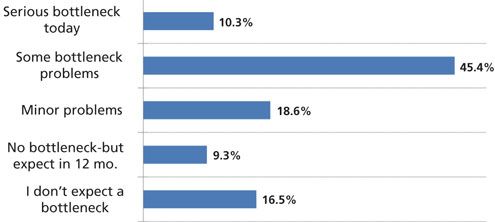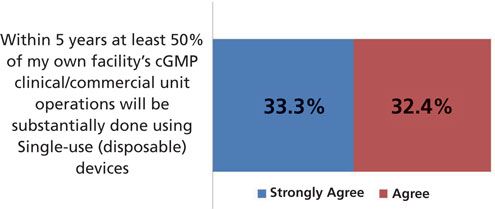Demand for Efficiency Spurs Bioprocessing Innovation
PTSM: Pharmaceutical Technology Sourcing and Management
The biopharma industry is growing at 14-15%, but efficiency demands and lack of skilled labor may impact performance.
Lightspring/shutterstock.com

The biopharmaceutical industry is dynamic and complex, and in addition to the overall consistent 14-15% industry growth, data from BioPlan Associates’ 2017 14th Annual Report and Survey of Biopharmaceutical Manufacturing (1) shows that key trends are affecting this growth. These include the following:
- Demand for production efficiency
- Growth of international biomanufacturing centers, including China
- Biosimilars expansions
- Cell- and gene-therapy approvals.
These general trends are also impacting more specific aspects of the industry. For example, current and future capacity and production are already being hit by the inability to hire and train staff-in fact, more than 50% of bioprocessing facilities are experiencing capacity problems this year due to difficulties hiring certain operations staff. Hiring problems will continue to increase as the industry expands. These human resources issues may ultimately also create quality problems, and are already increasing demand for technologies that reduce staffing, such as automation and single-use device applications. Even outsourcing to contract manufacturing organizations (CMOs) may well be challenged if CMOs continue to experience growth and hiring problems.
The biopharmaceutical industry is continuously demanding new and improved bioprocessing technologies to reduce costs, increase efficiencies, and improve weak development pipelines, especially in developing economies. Some of the ongoing biopharmaceutical trends support a future vision that includes:
- More biological products, but often each targets smaller markets
- More biosimilars and biogenerics
- More multi-product and flexible manufacturing facilities
- More adoption of single-use systems
- More efficient bioprocessing-titers and yields
- More use of continuous processing, including for downstream processing
- More automation, monitoring, and process control.
The following is a summary of a few of the top 15 trends affecting biopharmaceutical manufacturing from the BioPlan 2017 study. This year’s survey included responses from 227 bioprocessing professionals, 131 industry equipment and services suppliers; and data from more than 150 bioprocessing professionals in China and India.
Trend number one: Greater demand for manufacturing efficiency and productivity
Many of the trends in the bioprocessing industry are being driven by perceived needs for improved efficiencies, quality, and cost reductions in manufacturing processes. Companies invest in technology and innovation so they can more with less. To remain competitive, better ways are needed to:
- Make bioprocessing more efficient and less expensive
- Decrease new products’ time-to-market (increase speed)
- Streamline new technology testing and adoption, make adopting new technologies less painful.
The largest portion of survey respondents, 16.4%, noted that “Manufacturing Productivity/Efficiency” was the “single most important biomanufacturing trend or operational area on which the industry must focus its efforts, 2014–2017.” Essentially, all of the top three-and most other cited trends or operational areas-are related to cost savings though increased efficiency and productivity (see Figure 1).
Figure 1: Single most important biomanufacturing trend area, 2014-2017. (Figures are courtesy of the authors).

Related survey findings include:
- Average reported titer for commercial-scale biologics (for new monoclonal antibodies [mAbs]) this year was 2.80 g/L, with yearly data back to 2008 showing overall consistent year-to-year incremental increases to the present.
- Average reported upstream titers have been growing rather steadily over the past three decades from a baseline of at best a few tenths of a gram/L back in the 1980s.
- Average reported titer for clinical-scale biologics was 3.29 g/L, with these data also showing an overall consistent incremental growth.
Trend two: Downstream processing remains the major bioprocessing bottleneck
Downstream purification including chromatography continues to be the area cited as requiring the most technological improvements. Yet, other recent BioPlan studies confirm that downstream yield improvements remain much more resistant to change. This year, 74.3% of respondents reported their facility was experiencing at least some capacity bottleneck due to downstream processes. Overall, respondents are experiencing a higher level of bottlenecks than seen in 2011–2015. Approximately 10% reported that their facility is currently experiencing “serious” downstream bottleneck problems. CMOs perceive downstream bottlenecks as more serious, with 60% of CMO respondents reporting either “Serious” or “Some” capacity constraints due to downstream processing. “Serious” capacity constraints were also reported much more frequently by European vs. US respondents, 11.5% vs. 5.7% (see Figure 2).
Figure 2: Impact of downstream processing on overall capacity.

Chromatography remains the top-cited downstream (or any) bioprocessing problem area. This included 48.3% of respondents citing “Chromatography columns” as causing them “Moderate constraints” or worse; with 80.8% reporting “Minor constraints” or worse.
Trend three: Biosimilars are bringing more competing biopharmaceutical products (competition) and players
Biosimilar product development continues worldwide, and appears to be accelerating now that the US biosimilars’ market is coming online. The Biosimilars/Biobetters Pipeline Database (2) reports nearly 850 biosimilars (including biogenerics) in development or marketed worldwide, including approximately 125 in clinical trials; and more than 515 biobetters in development or marketed worldwide, including more than 200 in clinical trials. With such a healthy development pipeline, within approximately five years, biosimilars will outnumber reference and other innovative products, including in the US market. This increase will change the underlying nature of the biopharmaceutical industry, as biosimilar products eventually affect overall sales. CMOs are also reporting increased business, about 15% increase in revenue, attributed to biosimilars development projects.
Biosimilars are resulting in a number of new players entering the biopharmaceutical industry. Established drug companies, including Big Pharma, startup and virtual companies, foreign companies, generic-drug companies, and others are working to develop portfolios of biosimilars. The United States remains a primary location for biosimilar R&D and the largest market for biosimilars. Europe, India, and China are the other major centers for biosimilars development and marketing. A good portion of the new bioprocessing facilities and process lines have recently come online or under construction and will be solely or largely devoted to biosimilars manufacture.
Trend four: Single-use systems in demand, use still growing
Approximately 90% of respondents currently use single-use bioprocessing equipment, with “Tubing or disposable operations” cited the most. More than 80% reported use of single-use bioreactors. In contrast, the highest rate of reported downstream single-use systems use was “Disposable chromatography devices,” reported by 55.6% and membrane adsorbers at 49.6%. The rates of usage of diverse disposables in biopharmaceutical manufacturing have remained relatively steady in recent years, with the market nearing saturation, for smaller, clinical-scale operations. BioPlan estimates that approximately 85% of pre-commercial biopharmaceutical manufacture is done using single-use systems, particularly upstream. Sales of single-use systems will further increase as more manufacturers advance to commercially manufacture their products using single-use systems.
And the industry itself expects to see continued adoption. A significant majority (66%) expect their own facility to involve at least 50% of its substantial unit operations to be done using single-use system devices (see Figure 3).
Figure 3: Single-use/disposable device adoption factors.

Trend five: International growth in biomanufacturing; China and India are maturing
India, China, and other regions are rapidly increasing their domestic manufacturing capabilities; however, most of the current products are developed for home markets, including biogenerics (i.e., non-GMP biopharmaceuticals for lesser-regulated markets). While these are fast-growing geographic areas for biopharmaceutical R&D and manufacturing, little (as yet) involves innovative products. Growth in capacity and new and expanded facilities coming online are most rapid in China, India, Korea, and Singapore, but some of these countries’ capacities are growing from low baselines.
BioPlan’s analysis of China’s bioprocessing facilities, Top 60 Biopharmaceutical Facilities in China, (3) found that China holds approximately 2.4% of the total worldwide estimated 17 million L capacity for recombinant protein/mAb bioprocessing capacity. And nearly all growth in China is domestically financed, with foreign investment in Chinese biopharmaceutical manufacturing remaining relatively low.
Most biogeneric developers aspire to bring their products as biosimilars into major highly-regulated markets. But it will take years for developing country-based facilities (aside from a few outliers) to develop major market-friendly GMP manufacturing capabilities. Besides physical plant and needed staff expertise, improvements are needed in business culture, including aspects that have fostered persistent fraudulent data manipulation.
This year, the BioPlan survey includes data from interviews with 50 Chinese and more than 100 Indian bioprocessing professionals. Among the attributes noted as most required in Chinese facilities to enable international sales/competition are:
- More innovative biopharmaceutical pipeline (58%)
- Overall ‘quality’ image (50%)
- Capacity: Commercial scale (50%).
- In terms of citing the weaknesses, 52% cited “Scientific/technical expertise” and the same percentage noted “Compliance track record/expertise.”
- From Indian bioprocessing professionals, the core competencies noted as being lacking in Indian biopharmaceutical manufacturers included:
- Innovation/R&D product pipeline (35%)
- Production quality improvements (35%)
- Education, expertise, skills (16%).
Summary
Bioprocessing industry trends and innovation speeds discovery and can drive down costs and improve productivity. The current situation in biopharma is exciting, with new technologies, biosimilars, cell and gene therapies, and opportunities in emerging markets.
References
1. BioPlan Associates, 14th Annual Report and Survey of Biopharmaceutical Manufacturing Capacity and Production (BioPlan Associates, April 2017).
2. BioPlan Associates, Biosimilars/Biobetters Pipeline Database
3. BioPlan Associates, Top 60 Biopharmaceutical Facilities in China, 2nd edition (BioPlan Associates, February 2017).

Transformations in Drug Development for Cell and Gene Therapies
March 28th 2025As a recognized leader in immunophenotyping for clinical trials, Kevin Lang from PPD discusses how spectral flow cytometry is transforming drug development, particularly in cell and gene therapies like CAR-T. He also dives into his award-winning research, including his 2024 WRIB Poster Award-winning work, and his insights from presenting at AAPS PharmSci360.
Advancing Clinical Trials with Spectral Flow Cytometry: A Conversation with Kevin Lang
March 28th 2025As a recognized leader in immunophenotyping for clinical trials, Kevin Lang from PPD discusses how spectral flow cytometry is transforming drug development, particularly in cell and gene therapies like CAR-T. He also dives into his award-winning research, including his 2024 WRIB Poster Award-winning work, and his insights from presenting at AAPS PharmSci360.
Pharmaceutical Tariffs Are Imminent: How Industry is Bracing for Impact
April 16th 2025On April 14, 2025, the Trump Administration launched a national security-driven investigation into pharmaceuticals, a move that will likely result in tariffs being placed on pharmaceutical drugs, ingredients, and other components that are imported from outside of the United States.